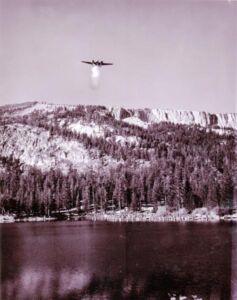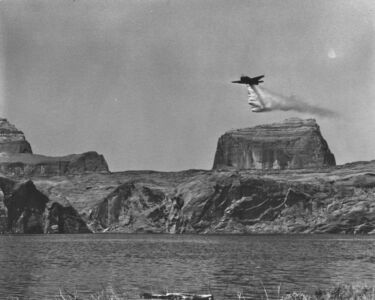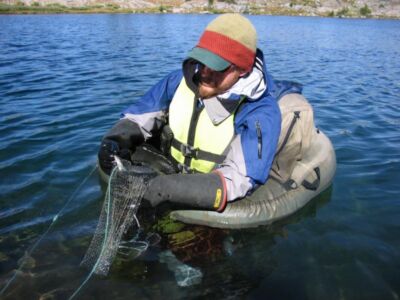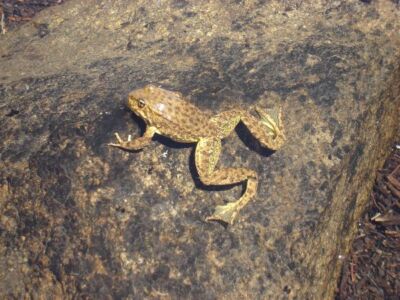Aerial Fish Stocking (and Removal) in the Sierra Nevada

After years of stocking the lakes of the Sierra Nevada using pack animals, the California Department of Fish and Game began using airplanes in the 1940s. Many of the lakes previously had no fish.
After years of stocking the lakes of the Sierra Nevada using pack animals, the California Department of Fish and Game began using airplanes in the 1940s. Many of the lakes previously had no fish.

A diagram of a typical aerial fish planting run, drawn by one of the pioneers: Carrol Faist.
A diagram of a typical aerial fish planting run, drawn by one of the pioneers: Carrol Faist.

The California Department of Fish and Game pioneered aerial fish planting in the years following World War II. In this photo, taken about 1950 in Bishop, CA, Dave Ward, Lee Talbot, Carrol Faist, and Jim McGregor prepare to load an WWII-surplus Beechcraft C-45 with fingerlings.
The California Department of Fish and Game pioneered aerial fish planting in the years following World War II. In this photo, taken about 1950 in Bishop, CA, Dave Ward, Lee Talbot, Carrol Faist, and Jim McGregor prepare to load an WWII-surplus Beechcraft C-45 with fingerlings.

Putting fingerling trout in a plane for stocking in Lake PowellPhoto by Rex Gary Schmidt. Courtesy of National Conservation Training Center. #4577
Putting fingerling trout in a plane for stocking in Lake PowellPhoto by Rex Gary Schmidt. Courtesy of National Conservation Training Center. #4577

Loading a plane with fish for stocking in Lake Powell.Photo by Rex Gary Schmidt. Courtesy of National Conservation Training Center. #4572
Loading a plane with fish for stocking in Lake Powell.Photo by Rex Gary Schmidt. Courtesy of National Conservation Training Center. #4572

With places like this, is it any wonder the high Sierra lakes are so popular with fishermen?Photo by Anders Halverson
With places like this, is it any wonder the high Sierra lakes are so popular with fishermen?Photo by Anders Halverson

Stocking rainbow trout in Lake PowellPhoto by Rex Gary Schmidt. Courtesy of National Conservation Training Center. #5066
Stocking rainbow trout in Lake PowellPhoto by Rex Gary Schmidt. Courtesy of National Conservation Training Center. #5066

Biologist Roland Knapp examines invertebrates he has sampled from a Sierra lake in July, 2006. Knapp has been studying the effects of fish removal on other inhabitants of such lakes including amphibians and invertebrates like these.Photo by Anders Halverson
Biologist Roland Knapp examines invertebrates he has sampled from a Sierra lake in July, 2006. Knapp has been studying the effects of fish removal on other inhabitants of such lakes including amphibians and invertebrates like these.Photo by Anders Halverson

Seasonal employees of the California Department of Fish and Game and the U.S. Forest Service remove fish from gillnets in a high Sierra lake.Photo by Anders Halverson
Seasonal employees of the California Department of Fish and Game and the U.S. Forest Service remove fish from gillnets in a high Sierra lake.Photo by Anders Halverson

A view of the Sierra Nevada from Fish Slough, where the last population of Owens pupfish were discovered by Phil Pister, Robert Miller, and Carl Hubbs in 1964.Photo by Anders Halverson
A view of the Sierra Nevada from Fish Slough, where the last population of Owens pupfish were discovered by Phil Pister, Robert Miller, and Carl Hubbs in 1964.Photo by Anders Halverson

A seasonal employee of the U.S. Forest Service removes a dead rainbow trout from a gillnet in a Sierra Nevada lake in the fall of 2006.Photo by Anders Halverson
A seasonal employee of the U.S. Forest Service removes a dead rainbow trout from a gillnet in a Sierra Nevada lake in the fall of 2006.Photo by Anders Halverson

Mountain yellow-legged frogs like this one have been declining due at least in part to fish stocking in the Sierra Nevada.Photo by Jason Kling (U.S. Forest Service)
Mountain yellow-legged frogs like this one have been declining due at least in part to fish stocking in the Sierra Nevada.Photo by Jason Kling (U.S. Forest Service)
